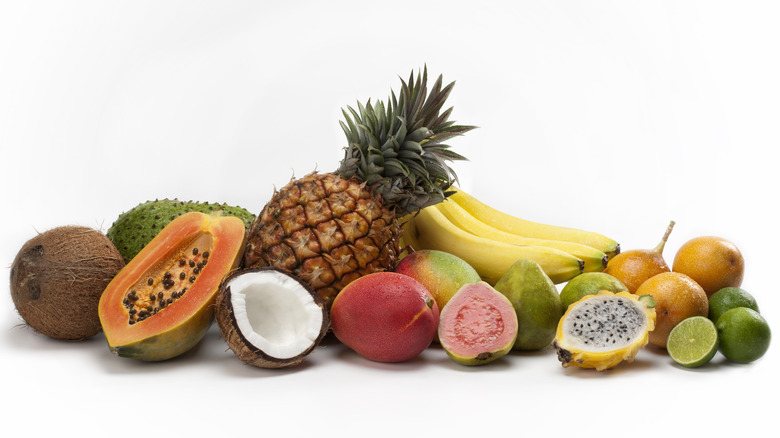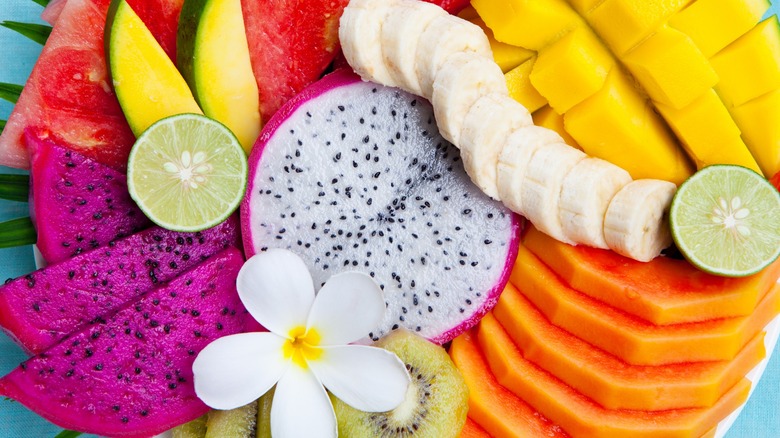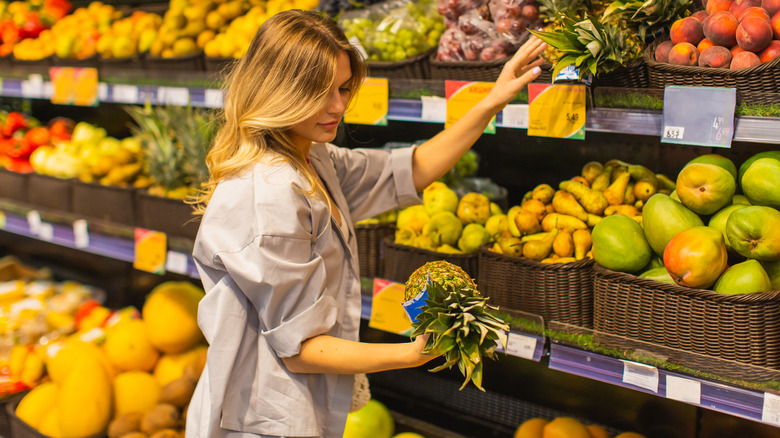The Best Time Of Year To Buy And Eat Tropical Fruits
In America, it can seem like fruits of all kind are constantly in season and at their peak, based on the fact that many — including tropical varieties — are in constant supply at many grocery stores. But, it's easy to forget that many are not just out of season in the U.S., but aren't native to the continent at all. Of course, if indigenous fruits were all we had access to, we'd never know the absolute joy of biting into a tropical fruit like a mango, guava, or papaya.
Even though these and many other tropical fruits are readily available for the most part, there are certain times of the year when they are at their very best. So, if you want to experience the most luscious pineapple or passionfruit you've ever had, you might need to practice some patience, but it will be well worth it. Fortunately, some of these fruits taste great all year-round, while others are at their peak in the dead of North America's winter, which may help to evoke warm, sunny vibes when you need them most.
When to enjoy a taste of the tropics
Tropical fruits are those that are grown in hot, humid areas of the earth including Asia, Africa, Central and South America, the Caribbean, and the South Pacific Ocean islands. By definition, the specific areas that produce tropical fruit are located along the Tropic of Cancer and the Tropic of Capricorn. Some of these fruits have been successfully cultivated in the United States, like cherimoyas (custard apples), passionfruit, and pomegranates, while others fare better in other countries but can be shipped around the world.
When it comes to peak season, mangos and papayas can be delicious year-round and are typically found at the supermarket all year. Passionfruit, coconut, Persian limes, and jackfruit are also considered fruits that should taste lovely from January through December. Lychee is at its peak in May and June, dragonfruit is best from June through December, and starfruit has an impressively long harvesting season, from June through February in the U.S. The ever-popular pineapple (arguably the very symbol of tropical fruit) is at its sweetest from March to July, despite its ubiquitous presence.
To take the guesswork completely out of the equation, consider joining a monthly tropical fruit club that will send you a selection of perfectly ripe fruits on a regular basis, all of which should be ready to enjoy as soon as they arrive on your doorstep.
When in doubt - see, smell, touch
Memorizing the seasonality of all the world's tropical fruits isn't the easiest task, and if you don't want to stand in the produce aisle looking the info up on your phone, you can always rely on some pretty foolproof clues. While some fruits are difficult to determine ripeness (like grapefruits with their thick skins and watermelons), most give off a pleasant smell when they are at their sweetest.
Fruit skin should also be unblemished and not bruised, any attached leaves should be a deep green color, and unless the fruit itself is green in color, it shouldn't have any traces of the emerald shade. If something looks dried and shriveled, move on to the next bin.
When you're bored with your normal rotation of fruit, selecting something new and tropical can be a great way to expand your palate. There are a range of tropical fruit salads from around the world that will surely put some sunshine in your culinary rotation, like Brazilian salada de frutas made with bananas, guava, pineapple, and oranges, and Moroccan citrus salad that features fresh citrus slices sprinkled with ruby-red pomegranate arils, cinnamon, honey, and orange blossom water.



